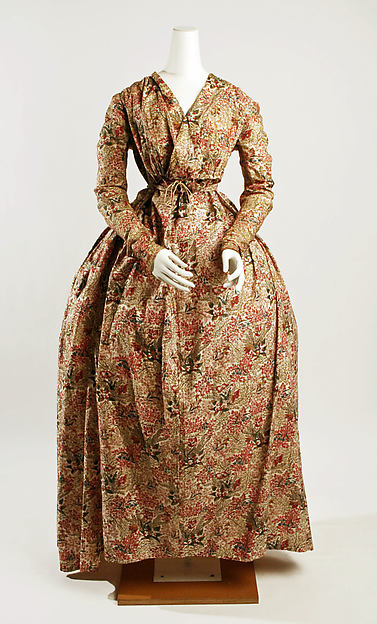Otherwise known as: What would reasonably still be in use by year XX13?
My costuming plans for this year include projects from the 1790s into the 1810s. The first step of any gown is the foundation. I have 1780s stays, but the 1790s gown is a transitional style and needed a different silhouette. My 1800s stays give too low a waistline, so I also wanted to replace them.
I'm fascinated by the transitional styles between the upright, long-waisted, big-skirted 18th century and the graceful, high-waisted, flowing skirts of the early 19th. Transitional stays are just as interesting. I decided to reproduce these ca. 1790 stays from the Victoria & Albert Musuem.
There is no pattern for these stays. I started with the diagram given for late 1790s stays on page 44 of
Corsets and Crinolines. These stays did not have the bust cups of the V&A stays, and they were longer, but the pattern pieces and boning lines were similar.
I enlarged the pattern using my printer/scanner and Adobe Acrobat:
1. Scan the pattern at medium resolution.
2. In Acrobat, open the Print window. Select Poster print and enlarge it. Easy!
In this case, I printed at both 350% and 400%. 350% was perfect for the scale, but I was afraid it would be too small so I started my mockup with the 400% pieces. It turns out that 350% would have fit me better, but who cares? :)
The only other major change to the pattern, besides adding the bust cups, was to shorten the whole thing 1" below the bust. The 1790s transitional style I'm focusing on all had slightly raised waists, so I had no interest in making these fit my waist.
I made 2.5 mockups. The first was in muslin with no boning, to get a general idea of the fit and where to fit the bust cups. The second muslin was in cheap cotton duck, with steel boning duck-taped to the inside. The duck tape worked perfectly! It tears down the middle into perfect casing-sized pieces. My mockup and the tape are both white, but hopefully it's clear in this picture.

Eventually I shortened the straps and tightened the seams enough to get a really good look. For a final check, I put on one of my Regency gowns. The red dot marks where the new waistline is, a good 1.5" higher than before. Success!
The stays are three layers: cotton drill, cotton sateen, and lightweight mauve wool. I debated using linen canvas, but the V&A stays are cotton and I saved the linen for another project.
I used a mix of 18th and 19th century techniques in construction. The V&A stays do not have a binding, so I ended up sewing all layers of each piece together at the side seams, with the top and bottom edges in to be hemmed later. The boning channels were machined.
Then I sewed the pieces to each other: wrong sides together, with a running stitch through all folded edges. It's a very strong, and rather ornamental.
The bust cups are only wool and sateen, gathered up on cording. I liked the multiple rows of cording because they give more support, similar to gussets in later stays.
The rest of the work was done by hand: setting in the bust cups, hemming all around, and 32 eyelets. I also sewed down a narrow 1/8" tape over the seams. I almost felt bad to cover them up, but I love the emphasis given by the white lines.
I waited as late as I could in the construction before inserting the reed. It's so much easier to work with stays when they're not all stiff and awkward!
There are some tweaks I still want to make, such as cutting the tabs further up, adding cording above them, and topstitching all around the edges, but I'm very pleased with my new stays!
Just the Facts, Ma'am (Does anyone else get that reference?)
The Challenge: HSF #1, Bi/Tri/Quadri/Quin/Sex/Septi/Octo/Nona/Centennial
Fabric: white cotton drill, white cotton sateen, mauve wool suiting
Pattern: Adapted from
Corsets and Crinolines, page 44.
Year: The V&A stays are c. 1790, but I think they're mid 1790s.
Notions: reed for boning; Sugar 'n' Cream cotton yarn for cording
How historically accurate is it? The shape is as accurate as I can make it. Construction is accurate, except for the use of the machine for basting, side seams, and boning channels. The wool suiting is a twill weave that may not be accurate. I think I used polyester thread, because I'm annoyed with my cotton thread curling so much, and linen would be more accurate anyway.
Hours to complete: Including patterning and mockup time, roughly 40 hours.
First worn: Only once with all the lacing, just to make sure they work.
Total cost: I didn't buy anything for this! Maybe $10 of fabric, and the reed was given to me.
My brother Trevor gets credit for an assist. I supplied him with reed,
scissors, ruler, nail file, trash can, and a list of lengths. During
the football games last Saturday, he measured, cut, and sanded 34 pieces
of reed boning for me. (That includes two that I broke in my final try-on.) Thank you so much,
Trevor!
 |
| The list of cut lengths I gave him is barely visible on the far right. |
The Historical Sew Fortnightly has already proved its worth for me. If it weren't for the challenge, I would not have decided on a design as quickly as I did. I'd still be dragging my way through the construction. But 10 days, I have one of my biggest 2013 projects out of the way. Now I can make pretty dresses to go over the stays!



























